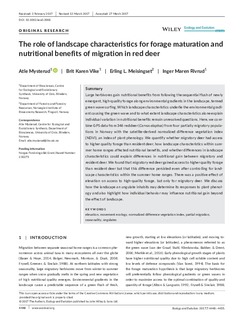| dc.contributor.author | Mysterud, Atle | |
| dc.contributor.author | Vike, Brit Karen | |
| dc.contributor.author | Meisingset, Erling L. | |
| dc.contributor.author | Rivrud, Inger Maren | |
| dc.date.accessioned | 2018-03-13T14:56:41Z | |
| dc.date.available | 2018-03-13T14:56:41Z | |
| dc.date.created | 2017-10-02T15:16:53Z | |
| dc.date.issued | 2017-05-12 | |
| dc.identifier.citation | Ecology and Evolution. 2017, 7 (12), 4448-4455. | nb_NO |
| dc.identifier.issn | 2045-7758 | |
| dc.identifier.uri | http://hdl.handle.net/11250/2490357 | |
| dc.description.abstract | Large herbivores gain nutritional benefits from following the sequential flush of newly emergent, high-quality forage along environmental gradients in the landscape, termed green wave surfing. Which landscape characteristics underlie the environmental gradient causing the green wave and to what extent landscape characteristics alone explain individual variation in nutritional benefits remain unresolved questions. Here, we combine GPS data from 346 red deer (Cervus elaphus) from four partially migratory populations in Norway with the satellite-derived normalized difference vegetation index (NDVI), an index of plant phenology. We quantify whether migratory deer had access to higher quality forage than resident deer, how landscape characteristics within summer home ranges affected nutritional benefits, and whether differences in landscape characteristics could explain differences in nutritional gain between migratory and resident deer. We found that migratory red deer gained access to higher quality forage than resident deer but that this difference persisted even after controlling for landscape characteristics within the summer home ranges. There was a positive effect of elevation on access to high-quality forage, but only for migratory deer. We discuss how the landscape an ungulate inhabits may determine its responses to plant phenology and also highlight how individual behavior may influence nutritional gain beyond the effect of landscape. | nb_NO |
| dc.language.iso | eng | nb_NO |
| dc.publisher | John Wiley and Sons | nb_NO |
| dc.rights | Navngivelse 4.0 Internasjonal | * |
| dc.rights.uri | http://creativecommons.org/licenses/by/4.0/deed.no | * |
| dc.subject | elevation | nb_NO |
| dc.subject | movement ecology | nb_NO |
| dc.subject | normalized difference vegetation index | nb_NO |
| dc.subject | partial migration | nb_NO |
| dc.subject | seasonality | nb_NO |
| dc.subject | ungulates | nb_NO |
| dc.title | The role of landscape characteristics for forage maturation and nutritional benefits of migration in red deer | nb_NO |
| dc.type | Journal article | nb_NO |
| dc.type | Peer reviewed | nb_NO |
| dc.description.version | publishedVersion | nb_NO |
| dc.rights.holder | © 2017 The Authors. Ecology and Evolution published by John Wiley & Sons Ltd. This is an open access article under the terms of the Creative Commons Attribution License, which permits use, distribution and reproduction in any medium, provided the original work is properly cited. | nb_NO |
| dc.source.pagenumber | 4448-4455 | nb_NO |
| dc.source.volume | 7 | nb_NO |
| dc.source.journal | Ecology and Evolution | nb_NO |
| dc.source.issue | 12 | nb_NO |
| dc.identifier.doi | 10.1002/ece3.3006 | |
| dc.identifier.cristin | 1501502 | |
| dc.relation.project | Norges forskningsråd: 230275 | nb_NO |
| cristin.ispublished | true | |
| cristin.fulltext | original | |
| cristin.qualitycode | 1 | |

